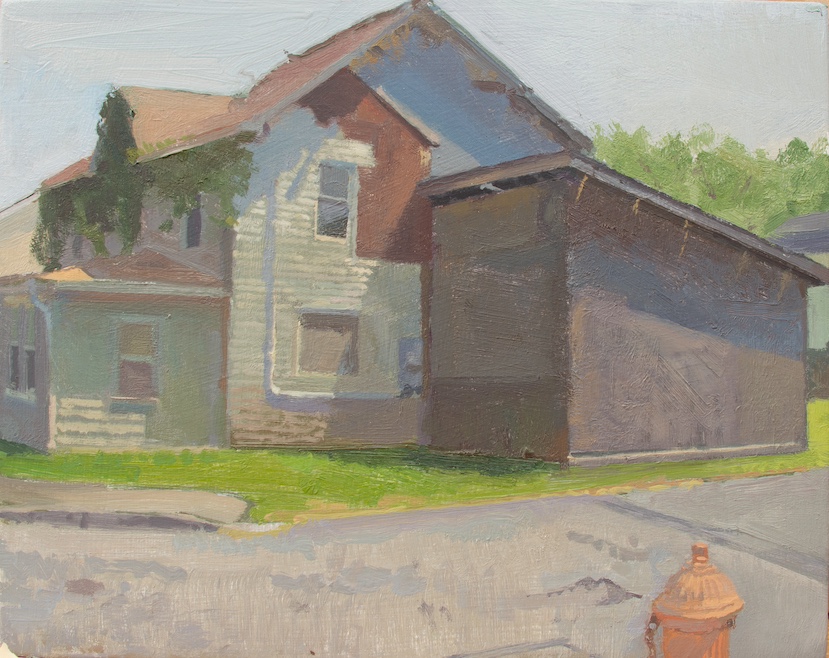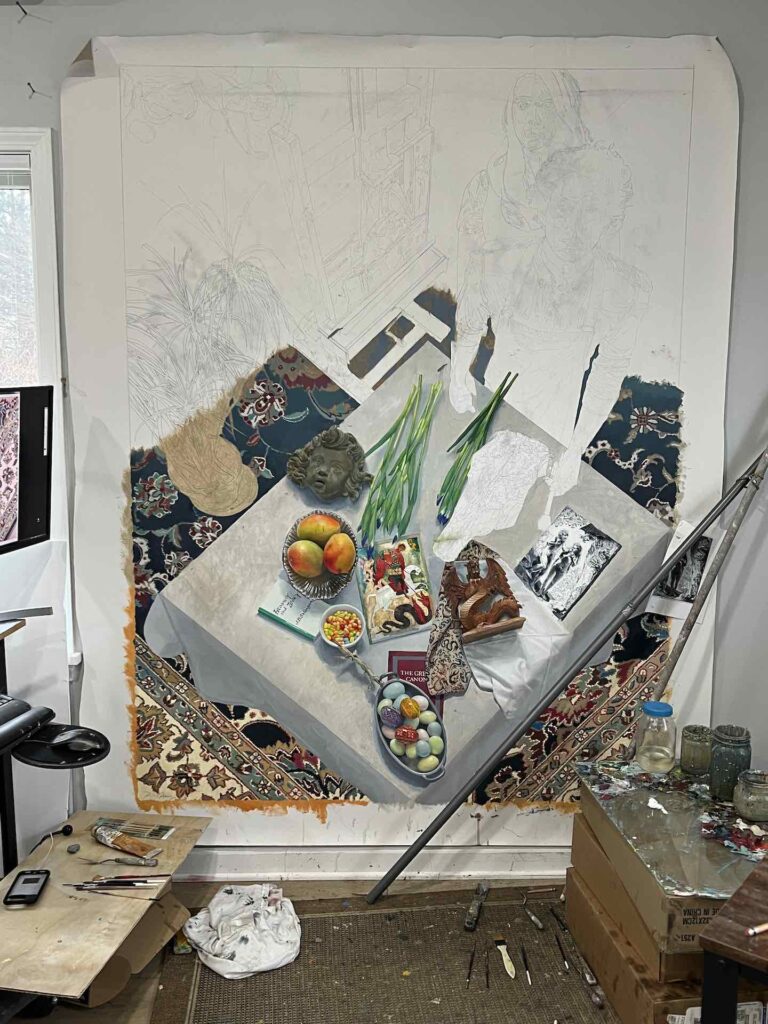January 31st, 2024 by dave dorsey

Matt Klos, Sycamore Avenue, oil on panel, 8″ x 10″, 2023
Matt Klos and Nora Sturges are showing new work at Anne Arundel Community College in the The Cade Center for Fine Arts Gallery. Matt is from my hometown, and he showed his work for a number of years here at Oxford Gallery and now teaches at Anne Arundel Community College in Arnold, Maryland. Years ago, he was also a student of my friend Bill Stephens. It’s always a great pleasure to see his new work. He’s constantly finding pictorial opportunities usually in overlooked places most people would rarely pause to admire. Yet his achievement isn’t simply to show you what’s physically visible, but to convey a time of day, a quality of light and a season. You see what he saw in the short period of time it took to paint these small pieces, but his images root themselves in a stillness that reaches out far beyond a particular moment. His statement, below, on the new work is eloquent. What follows is from his email invitation to the show.
Street View: Paintings by Matt Klos & Nora Sturges
EXHIBITION ON VIEW
The exhibit is open February 2 – March 1
RECEPTION: Feb. 8. 5-7pm
In “Street View,” painters Matt Klos and Nora Sturges investigate the visual contours and terrain of cityscapes both near and far from home. Klos’ series A Community Portrait investigates his historically working-class community of Sparrows Point by tracing the alleyways and painting on site. Generally, each painting spans a few hours of working time to capture a particular light, time of day, and season. In the series The View from the Road, Sturges paints from screenshots she takes in Google Street View following the route Charles Darwin took on his voyage with the Beagle (1832-36). These meticulously crafted paintings reveal idiosyncratic contemporary moments. Both artists value discovery by looking closely. Their ideas are couched in the time required to paint in an empirical and investigative manner.
MATT KLOS: “This project is a series of small format paintings of my community made during my sabbatical in spring 2023. Subjects include the outbuildings as seen from the back alleys near my home and front views of houses along a historically black and landlocked street in Sparrows Point, MD. Over the last twenty years I’ve spent time observing these often-overlooked areas, which I have seen on walks at various times of day. I’m often surprised by the endless variations and beauty found here. As we increasingly choreograph our identities via social media, slavishly attending to every detail of how we may be perceived, it’s refreshing to see a dimension of our public facing selves that is not as self-conscious and as premeditated. Our homes reveal volumes. I see each painting in this project as a type of portrait and, as such, communicates both specific and general truths about our communities and ourselves.”
NORA STURGES: “Since 2008, I have worked intermittently on a series of tiny paintings collectively called The View from the Road. My original inspiration was the early color photographs of Sergei Prokudin-Gorskii, who set out in 1905 to document the Russian empire, and my paintings offered me an opportunity to document the interesting things I saw on my own travels, out in the world near home and farther afield. During the pandemic, deprived of actual travel, I found myself devoting considerable time to exploring foreign places in Google Street View, and wanting to paint the wonderful things I was discovering. Instead of using chance or previous knowledge to choose places to explore, I decided to follow the route Charles Darwin took on his voyage with the Beagle (1832-36). Like Darwin, I am convinced of the value of observation, especially the intense observation painting entails, even when the subject is, on the surface, boring. Darwin’s observations led, years later, to the theories of natural selection and evolution he set forth in On the Origin of Species; already my voyage and observations are leading me to ideas about the human species.”
FOR MORE INFORMATION: Contact Chris Mona, Interim Director, Cade Art Gallery, at cpmona@aacc.edu
January 28th, 2024 by dave dorsey

George’s Dream in progress
I realized today that I haven’t posted here for nearly a season. I’ve been absorbed by the largest painting I’ve ever undertaken, a departure from almost everything I’ve done so far. I’m moving off the edge of the map of what I know how to do, and it’s both unsettling and exhilarating. It’s a one-off effort is how I look at it; I’m not seeing a series of paintings like this in my future. Oxford Gallery has a group show on the theme of dreams in April, and I’m hoping to finish this in time to have it in the show. It’s not the smartest thing to be doing right now, given the fact that my taffy paintings have been selling, but the opportunity emerged to put myself on a deadline and get this thing finished after thinking about it for the past couple years. I’d be smarter to do half a dozen more taffy paintings on the chance that Arcadia Contemporary will sell most of the work it shows at the LA Art Show next month. But if that work sells, I should be able to begin producing more work for Arcadia in March.
All of this has been going through my head: can I finish this big canvas in time for Oxford and will I be able to return to some taffy paintings without missing more than a beat or two when this one is finished? I think so, but wasn’t feeling it until this week when the still life portion began to look closer to completion. I’ve been so focused on the considerable demands of this painting that I’ve neglected the blog and Instagram and opportunities to have more fun than I deserve. I also have a solo show, a review of work from the past ten years, at SUNY Finger Lakes Community College coming up in a month. (As Spoon sings, everything hits at once.) I have more than enough work to provide for the show, candy jars from a decade ago, a sampling of still lifes over the years since then, and several taffy paintings that aren’t on their way to Los Angeles. That said, most of my time every day has been devoted to inching my way up from the bottom of this canvas to the top.
This work is a departure for me in that it’s intentionally meant to evoke a narrative. I’ve done tabletop paintings, gazing down from overhead on a square table covered with a white cloth, objects arranged randomly with more consideration for shape and color than anything else. They have suggested narratives to some of my friends, but that was never the intention. Like Chardin I tend to reuse familiar and favorite things in my still life paintings simply for their formal qualities, shape and color and so on: a cream pitcher, jelly beans, flowers from my garden or the supermarket, art books, CDs or mobile devices, patterned napkins. In this one the objects are chosen to serve as props for a painting about good and evil. They are under consideration by the painter who hasn’t been painted yet: his outline with the drawing of a woman standing behind him, appears behind the table on the right. Beside and slightly behind them, in the right/center, stands an easel with a painting of a human skull on the drawer than supports it. In the upper right corner, there’s a sketch of an angel I’ve quoted from Chagall’s huge painting where he depicts himself grinning, perched on his wife’s shoulders holding a wine glass to the sky. George’s Dream is about the painter who has yet to appear except as a line drawing. It’s a visualization of this painter’s dream, his assembly of objects to represent a modernization of that St. George and the Dragon legend. It’s up to the viewer to speculate on how the objects on the table figure into this project. The etching just below the painter’s hand is by Rembrandt, Adam and Eve in the garden, with the exchange of an apple in the offing, and in the upper corner of that print, there’s a dragon attaching himself to the tree trunk, looking as if he’s ready to pounce, more like Hobbes in the cartoon series than a dinosaur with bat’s wings.
I look forward to making a little, incremental progress on this image every day. Even the finished looking objects would benefit from more work. The Salinger book isn’t white enough where the light hits it. The etching is too white overall. There’s a blank space for a cow skull on the table. I’ve been indicating areas of flat color and then working on individual areas and object until they are finished. The tablecloth is just two areas of flat color at this point.
I have a backlog of little posts I’ve wanted to do about various other artists whose work I’ve seen since last October, and I’m hoping to get some quick observations off for a while now. I’m still finishing my fourth reading of Proust and my thoughts on that book could fill a book, but he is one of the greatest novelists for a painter to read, since he was influenced by a number of painters in his writing and much of what he says uses paintings as reference points and metaphors. His work is inexhaustibly intelligent, insightful and ultimately unique: what he was doing was spiritually radical in a way no one has really fully explored except for how Samuel Beckett touches on it in his long essay. More to come.

